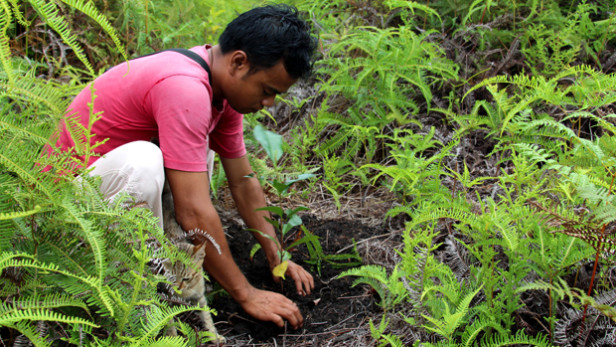
A staff member from the Pesalat Reforestation Project in Central Kalimantan, Indonesia (on the island of Borneo) is replanting trees in vital peat swamp forest areas, which were cleared by fires and logging. Restoring degraded land may be the answer to food scarcity, deforestation and desertification. Photo by: World Research Institute / CC BY-NC-SA
The solution to the very visible global problems of deforestation, desertification and food scarcity may be hiding in plain sight: the transformative ability to restore degraded land to productive use.
This is a resource opportunity of unprecedented magnitude. Two billion hectares— an area twice the size of Europe — of degraded land are ripe for landscape restoration. The expected rise in world population to 9 billion by 2050, and the need for a 70 percent increase in food production from 2006 levels, makes the need for a solution particularly urgent. This challenge will be even more difficult in the face of a changing climate.
Restoring these degraded lands would also be a huge blessing to millions of small farmers who depend on agriculture for their livelihoods — and it offers the additional benefit of mitigating climate change while helping farmers adapt to it. Restoring 150 million hectares would yield $84 billion in annualized net present value and would sequester approximately 1 gigaton of carbon dioxide equivalent annually.
What is required now is the political momentum to do so.
Today, we are paying a heavy human and economic price for our lack of preparedness from the impacts of land degradation and climate change. When food riots broke out in several countries in 2007 and 2008, we were unprepared. When drought hit the Horn of Africa in 2011, we were not ready. In 2012, donors spent over $1 billion in humanitarian assistance in the drought-ravaged Sahel region.
We know what needs to be done. With each passing year, the international community learns more about restoring the productivity and function of degraded lands and rebuilding the resilience of the rural poor. We know that herders, farmers and other vulnerable populations must adapt to climate change. We all generally agree upon the critical roadblocks to scaling up landscape restoration: weak land rights, poor governance, deficient financial systems and cross-ministerial rivalries.
However, our knowledge has not translated to action. Land degradation and climate change have vastly outpaced attempts to restore productivity to the land. Warmer temperatures and more extreme weather are causing not only human casualties, but also significant damage to agriculture and infrastructure.
Large-scale transformation
What is needed now is to put our knowledge into practice.
In the West African Sahel, for example, widespread adoption of what is called farmer managed natural regeneration in Niger has increased annual food production by some 500,000 tons and increased household incomes by $1000 per year. Smallholder farmers have protected and managed nearly 5 million hectares of on-farm trees, which produce fodder for livestock, improve soil fertility and create a more favorable microclimate for growing crops — all with minimal investment costs. Innovative farmers in Burkina Faso, Mali and Malawi are also making significant investments in improved land and water management, as well as restoring rural landscapes to achieve greater food security and adapt to climate change.
This kind of large-scale transformation is what can happen when millions of farmers are able to invest in sustainable land management practices.
Local governments are essential to such transformations. In Ethiopia’s Tigray region, more than 100,000 hectares of heavily degraded land, often on steep slopes, has been treated with a range of simple techniques forcing rainfall and runoff to soak into the soil and restore the vegetation. It has recharged groundwater valleys, allowing farmers to dig shallow wells to irrigate crops during the dry season. Recovering degraded land for production is a key priority not only for the regional but also the national government, which wants to restore about 15 million hectares.
Busting myths
There are a growing number of examples of restoration and rehabilitation successes where farmers are adapting to climate change and increasing their productivity. But if the successes are so clear, what’s holding us back? There are at least two myths keeping decision makers from fully seizing opportunities for forest and landscape restoration:
1. “It takes a generation before farmers will reap the benefits of their investments in land rehabilitation and restoration.” The experience from the dry West African Sahel shows that simple water harvesting techniques allow farmers to produce a crop from the first year.
2. “Recovering degraded land and adapting to climate change is expensive and economically irrational.” Restoring degraded land offers multiple benefits that often include increased crop production, drought resilience, a recharge of groundwater or re-emergence of permanent springs. These benefits have economic value — yet economists have not always quantified them in monetary terms.
Rapid change is possible. In the 1980s, for instance, maternal and infant mortality were issues at a complete standstill, with rates sky-high. Yet the issue was not lack of understanding of the constraints: what was needed was political will. With widespread commitment to tackling maternal and infant mortality, rates were able to fall dramatically over only a few years.
Land rehabilitation and restoration have been at a similar impasse. When it comes to restoring landscapes, we know what to do and how to do it. What is needed now is bold action.
What will this bold action look like? We need to engage politicians and decision-makers and make a compelling case for doing what is good for the economy and the environment, by investing in practices that restore degraded lands and enable farmers, herders and other land users to adapt to climate change. We invite you to join us in supporting this critical movement to restore the forests and landscapes we all depend upon. |